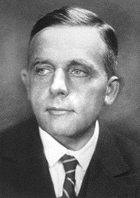|
Instituut voor Studie van Schimmel in Menselijke Woningen |
|
Institut pour l'Etude de Moisissure Fongique dans Habitations Humaines |
|
Forschung Insitute für Schimmelpilze in Innenräumen |
|
MYCOLOGICAL INSTITUTE |
|
for the study of |
|
FUNGAL MOLD IN HUMAN HABITATIONS |
1953 Celebrating 50 Years of DNA 2003
Otto Warburg
|
|
|
1927 Nobel Prize in Phisiology
Otto Warburg – Biography
 Otto Heinrich
Warburg was born on October 8, 1883, in Freiburg, Baden. His father, the
physicist Emil Warburg, was President of the Physikalische Reichsanstalt,
Wirklicher Geheimer Oberregierungsrat. Otto studied chemistry under the
great Emil
Fischer, and gained the degree, Doctor of
Chemistry (Berlin), in 1906. He then studied under von Krehl and obtained
the degree, Doctor of Medicine (Heidelberg), in 1911. He served in the
Prussian Horse Guards during World War I. In 1918 he was appointed
Professor at the Kaiser Wilhelm Institute for Biology, Berlin-Dahlem.
Since 1931 he is Director of the Kaiser Wilhelm Institute for Cell
Physiology, there, a donation of the
Rockefeller Foundation
to the Kaiser Wilhelm Gesellschaft, founded the previous
year.
Otto Heinrich
Warburg was born on October 8, 1883, in Freiburg, Baden. His father, the
physicist Emil Warburg, was President of the Physikalische Reichsanstalt,
Wirklicher Geheimer Oberregierungsrat. Otto studied chemistry under the
great Emil
Fischer, and gained the degree, Doctor of
Chemistry (Berlin), in 1906. He then studied under von Krehl and obtained
the degree, Doctor of Medicine (Heidelberg), in 1911. He served in the
Prussian Horse Guards during World War I. In 1918 he was appointed
Professor at the Kaiser Wilhelm Institute for Biology, Berlin-Dahlem.
Since 1931 he is Director of the Kaiser Wilhelm Institute for Cell
Physiology, there, a donation of the
Rockefeller Foundation
to the Kaiser Wilhelm Gesellschaft, founded the previous
year.
Warburg's early researches with Fischer were in the
polypeptide field. At Heidelberg he worked on the process of oxidation.
His special interest in the investigation of vital processes by physical
and chemical methods led to attempts to relate these processes to
phenomena of the inorganic world. His methods involved detailed studies on
the assimilation of carbon dioxide in plants, the metabolism of tumors,
and the chemical constituent of the oxygen transferring respiratory
ferment. Warburg was never a teacher, and he has always been grateful for
his opportunities to devote his whole time to scientific research. His
later researches at the Kaiser Wilhelm Institute have led to the discovery
that the flavins and the nicotinamide were the active groups of the
hydrogen-transferring enzymes. This, together with the iron-oxygenase
discovered earlier, has given a complete account of the oxidations and
reductions in the living world. For his discovery of the nature and mode
of action of the respiratory enzyme, the Nobel Prize has been awarded to
him in 1931. This discovery has opened up new ways in the fields of
cellular metabolism and cellular respiration. He has shown, among other
things, that cancerous cells can live and develop, even in the absence of
oxygen.
In addition to many publications of a minor nature, Warburg
is the author of Stoffwechsel der Tumoren (1926), Katalytische
Wirkungen der lebendigen Substanz (1928), Schwermetalle als
Wirkungsgruppen von Fermenten (1946), Wasserstoffübertragende
Fermente (1948), Mechanism of Photosynthesis (1951),
Entstehung der Krebszellen (1955), and Weiterentwicklung der
zellphysiologischen Methoden (1962). In the last years he added to the
problems of his Institute: chemotherapeutics of cancer, and the mechanism
of X-ray's action. In photosynthesis he discovered with Dean Burk the
I-quantum reaction that splits the CO2, activated by the
respiration.
Otto
Warburg is a Foreign Member of the Royal Society , London (1934) and a member
of the Academies of Berlin, Halle, Copenhagen, Rome, and India. He has
gained l'Ordre pour le Mérite, the Great Cross, and the Star and Shoulder
Ribbon of the Bundesrepublik. In 1965 he was made doctor honoris causa at
Oxford University
.
He is unmarried
and has always been interested in equine sport as a pastime.
From Nobel Lectures, Physiology or Medicine 1922-1941, Elsevier Publishing Company, Amsterdam, 1965
This autobiography/biography was written at the time of the award and later published in the book series Les Prix Nobel / Nobel Lectures. The information is sometimes updated with an addendum submitted by the Laureate. To cite this document, always state the source as shown above.
Otto Warburg died on August 1, 1970.

